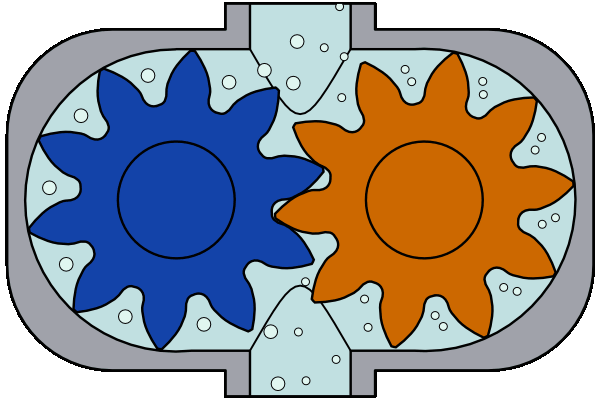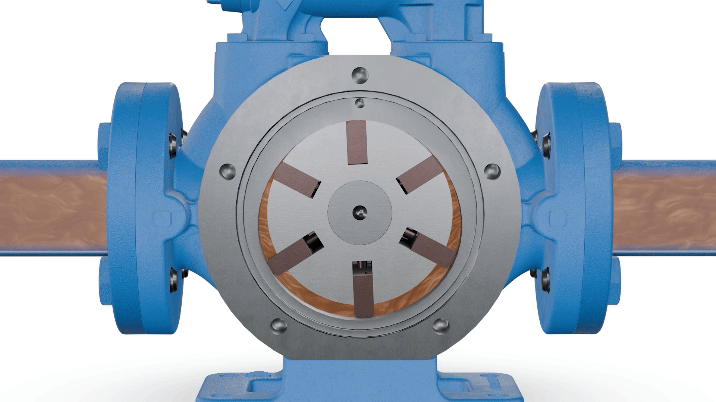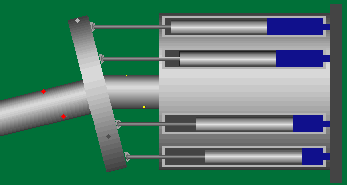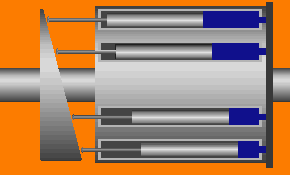Now, let’s explore the most common types of pumps, each with its unique design, strengths, and ideal applications.
Gear Pumps: The Rugged Workhorse

The Gist: Simple, rugged, and cost-effective, gear pumps are the go-to choice for many medium-pressure applications where reliability is key.
How It Works: Imagine two gears meshing together inside a tight housing. As they rotate, they create a vacuum on the inlet side, drawing fluid in. The fluid is trapped in the gaps between the gear teeth and the housing, carried around to the outlet, and forced out as the gears mesh again.
Key Characteristics & Applications:
- Pressure Range: Typically up to 250 bar.
- Displacement: Fixed. The flow rate is only adjustable by changing the pump’s speed (RPM).
- Efficiency: Volumetric efficiency is generally between 85-95%. They are less efficient than piston pumps.
- Pros: Cost-effective, highly reliable, and very tolerant of hydraulic fluid contamination. Catastrophic failures are rare; they usually wear down gradually.
- Cons: Can be noisy, operate at lower efficiencies, and have a fixed displacement.
- Common Applications: Log splitters, hydraulic power packs, lubrication systems, and auxiliary functions on heavy equipment.
The Formula (Displacement Volume): The displacement of an external gear pump depends on the geometry of its gears.
\[V_d \approx \frac{\pi}{4} \times (D_o^2 - D_i^2) \times W\]Where:
- $V_d$ = Displacement Volume (e.g., cm³/rev)
- $D_o$ = Outer Diameter of the gears (cm)
- $D_i$ = Inner Diameter of the gears (at the root, cm)
- $W$ = Width of the gears (cm)
Vane Pumps: The Quiet Operator

The Gist: Known for their low noise levels and high efficiency, vane pumps are a popular choice for industrial and mobile applications with mid-range pressures.
How It Works: A slotted rotor spins inside a cam ring. Rectangular vanes slide in and out of these slots. The offset between the rotor and the ring causes the vanes to create chambers of expanding and contracting volume. Fluid is drawn in where the chambers expand and forced out where they contract.
Key Characteristics & Applications:
- Pressure Range: Generally up to 200 bar.
- Displacement: Can be fixed or variable. Variable displacement models can adjust their output flow, which is great for energy savings.
- Efficiency: Higher volumetric efficiency than gear pumps (typically 85-92%).
- Pros: Very low noise output, low pressure ripple (smooth flow), and high efficiency.
- Cons: Less tolerant of contamination and high pressures compared to piston pumps.
- Common Applications: Die-casting and injection molding machines, power steering systems, and mid-range hydraulic presses.
The Formula (Displacement Volume):
\[V_d = \frac{\pi}{2} \times (D_c + D_r) \times e \times W\]Where:
- $V_d$ = Displacement Volume (cm³/rev)
- $D_c$ = Diameter of the cam ring (cm)
- $D_r$ = Diameter of the rotor (cm)
- $e$ = Eccentricity between the ring and rotor (cm)
- $W$ = Width of the vanes (cm)
Piston Pumps: The High-Pressure Champions
Piston pumps are the heavy-hitters of the hydraulic world, capable of producing the highest pressures and offering the best overall efficiency. They are the top choice for demanding applications. There are several designs, with the most common being bent-axis and inline (swashplate) types.
Bent-Axis Piston Pumps

The Gist: The most efficient hydraulic pump design available, capable of very high pressures and speeds.
How It Works: The cylinder block is turned by the driveshaft but is set at an angle to it (the “bent axis”). This angle causes the pistons to reciprocate within the cylinder bores, creating the pumping action. A larger angle results in a longer piston stroke and greater displacement.
Key Characteristics & Applications:
- Pressure Range: Often exceeds 400 bar for continuous operation.
- Displacement: Can be fixed or variable.
- Efficiency: The highest of all pump types, with total efficiencies often exceeding 95%.
- Pros: Extremely high efficiency, high pressure and speed capabilities, very durable.
- Cons: High cost, large physical size, and complex design.
- Common Applications: Heavy-duty construction and mining equipment (excavators, dump trucks), forestry machinery, and industrial manufacturing.
Inline Axial (Swashplate) Piston Pumps

The Gist: A more compact and common design than the bent-axis pump, offering excellent performance and versatility for high-pressure systems.
How It Works: The pistons and cylinder block are in line with the driveshaft. The pistons are connected to a rotating swashplate, which is set at an angle. As the swashplate turns, it pushes the pistons in and out of the cylinder block, creating the pumping action. The angle of the swashplate determines the flow rate.
Key Characteristics & Applications:
- Pressure Range: Similar to bent-axis, often 350-420 bar.
- Displacement: Almost always variable, with sophisticated control options (pressure compensation, load sensing).
- Efficiency: Very high, nearly on par with bent-axis pumps.
- Pros: More compact and less expensive than bent-axis designs, highly versatile controls for energy savings.
- Cons: Slightly less efficient than bent-axis pumps and more sensitive to fluid contamination.
- Common Applications: The most widely used variable pump, found in everything from mobile cranes and farm equipment to industrial power units.
The Formula (Displacement for Piston Pumps): The displacement is the volume swept by all pistons in one full revolution.
\[V_d = A_p \times s \times n\]Where:
- $V_d$ = Displacement Volume (cm³/rev)
- $A_p$ = Area of a single piston (cm²)
- $s$ = Piston stroke length (cm)
- $n$ = Number of pistons
Summary: Choosing the Right Pump
Selecting the right hydraulic pump is a balancing act between performance, efficiency, and cost. Here’s a quick comparison to help guide your decision:
| Pump Type | Pressure Range | Efficiency | Cost | Key Advantage |
|---|---|---|---|---|
| Gear Pump | Low to Medium | Good | Low | Simple & Robust |
| Vane Pump | Medium | Very Good | Medium | Low Noise |
| Piston Pump | Very High | Excellent | High | High Pressure & Efficiency |
Ultimately, understanding the fundamental requirements of your hydraulic system—the speed (flow) and force (pressure) it needs—is the first step toward harnessing the incredible power of hydraulics.
